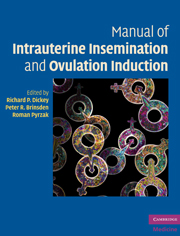Book contents
- Frontmatter
- Contents
- List of contributors
- Preface
- 1 An overview of intrauterine insemination and ovulation induction
- 2 Male causes of infertility: evaluation and treatment
- 3 Female causes of infertility: evaluation and treatment
- 4 Clinic and laboratory design, personnel and equipment
- 5 Semen analysis: semen requirements for intrauterine insemination
- 6 Semen preparation for intrauterine insemination
- 7 Ovulation induction for intrauterine insemination I: oral drugs clomiphene, tamoxifen, letrozole
- 8 Ovulation induction for intrauterine insemination II: gonadotropins and oral drug–gonadotropin combinations
- 9 Ultrasonography in the management of ovulation induction and intrauterine insemination
- 10 Insemination technique and insemination complications
- 11 Cryopreservation
- 12 Donor sperm
- 13 The role of the nurse in intrauterine insemination and ovulation induction
- 14 Complications of ovulation induction I: high-order multiple births, miscarriage, ectopic pregnancy, congenital anomalies, ovarian cancer
- 15 Complications of ovulation induction II: ovarian hyperstimulation syndrome, ovarian torsion
- 16 The psychological issues of intrauterine insemination
- 17 Ethical, legal and religious considerations of artificial insemination
- Index
2 - Male causes of infertility: evaluation and treatment
Published online by Cambridge University Press: 01 February 2010
- Frontmatter
- Contents
- List of contributors
- Preface
- 1 An overview of intrauterine insemination and ovulation induction
- 2 Male causes of infertility: evaluation and treatment
- 3 Female causes of infertility: evaluation and treatment
- 4 Clinic and laboratory design, personnel and equipment
- 5 Semen analysis: semen requirements for intrauterine insemination
- 6 Semen preparation for intrauterine insemination
- 7 Ovulation induction for intrauterine insemination I: oral drugs clomiphene, tamoxifen, letrozole
- 8 Ovulation induction for intrauterine insemination II: gonadotropins and oral drug–gonadotropin combinations
- 9 Ultrasonography in the management of ovulation induction and intrauterine insemination
- 10 Insemination technique and insemination complications
- 11 Cryopreservation
- 12 Donor sperm
- 13 The role of the nurse in intrauterine insemination and ovulation induction
- 14 Complications of ovulation induction I: high-order multiple births, miscarriage, ectopic pregnancy, congenital anomalies, ovarian cancer
- 15 Complications of ovulation induction II: ovarian hyperstimulation syndrome, ovarian torsion
- 16 The psychological issues of intrauterine insemination
- 17 Ethical, legal and religious considerations of artificial insemination
- Index
Summary
Introduction
The male is solely responsible for the failure to conceive in about 20% of infertile couples, and contributory in another 30–40%. Reduced male fertility can derive from congenital or acquired urogenital abnormalities, infection of male accessory glands, increased scrotal temperature, endocrine disturbances, genetic abnormalities or immunological factors. However, no demonstrable etiology can be diagnosed in 48.5% of cases of male infertility. An abnormal semen analysis (SA) suggests the presence of a male factor; however, a normal SA does not preclude a male factor being present.
The goals of the evaluation of the infertile male are to identify:
potentially correctable conditions
irreversible conditions amenable to assisted reproductive technologies (ART) using male gametes or donor insemination if the male partner's sperm is not procurable
life- or health-threatening conditions that may underlie infertility and require medical attention
genetic abnormalities that may affect the health of off spring if passed on via advanced reproductive techniques.
Traditionally, evaluation of infertility is postponed until one year of unprotected intercourse. However, it is justified to initiate an evaluation earlier if one of the following conditions is present:
defined male infertility risk factors
female infertility risk factors, including advanced age (> 35 years)
the male or female partner requests an earlier evaluation.
Initial evaluation of the male usually consists of two semen analyses separated by at least a month, a medical and reproductive history, and a focused physical examination by a urologist/andrologist.
- Type
- Chapter
- Information
- Publisher: Cambridge University PressPrint publication year: 2009



